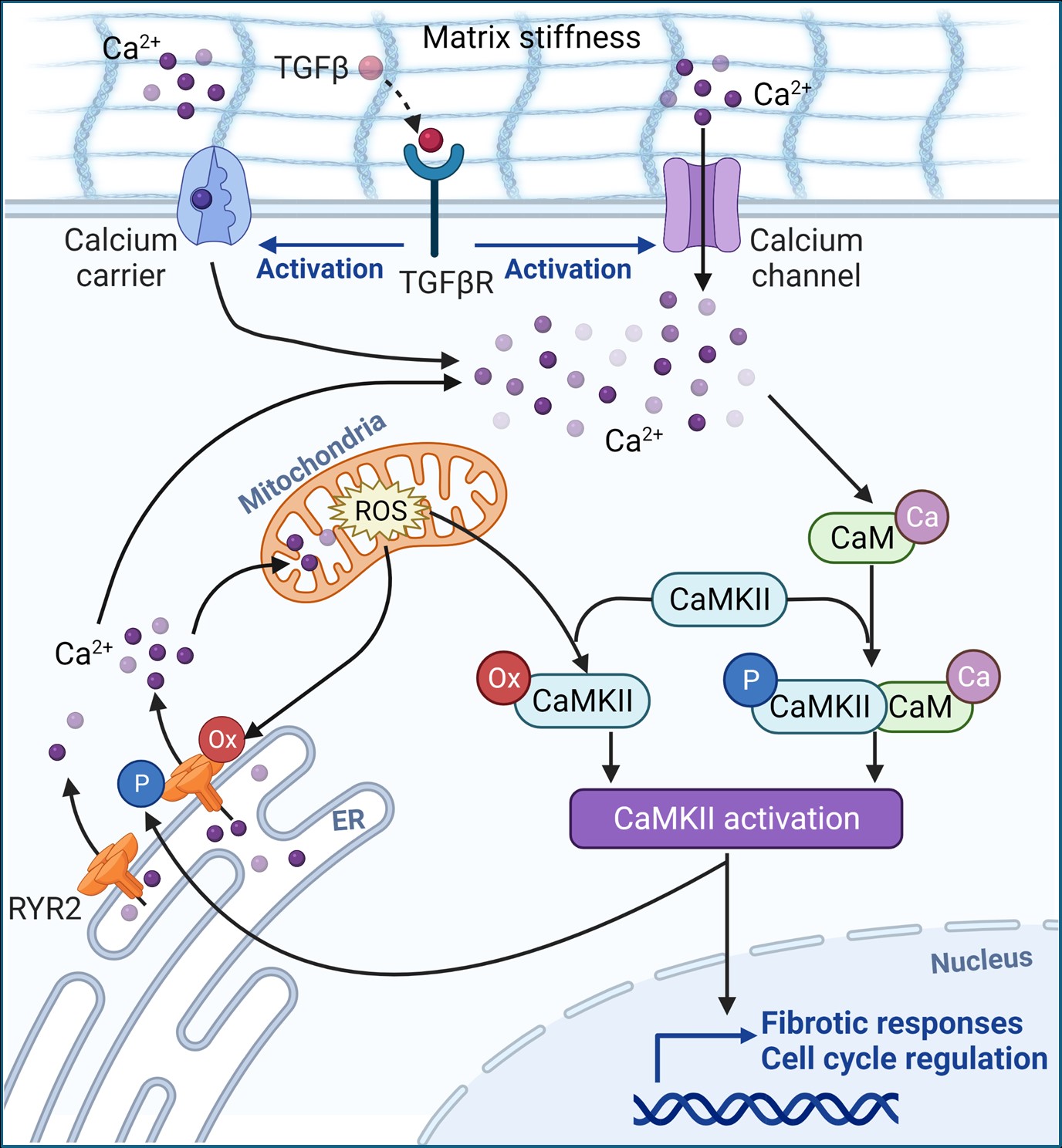Session Information
Date: Monday, November 18, 2024
Title: Systemic Sclerosis & Related Disorders – Basic Science Poster II
Session Type: Poster Session C
Session Time: 10:30AM-12:30PM
Background/Purpose: Prior research has suggested that manipulating intracellular Ca2+ concentrations might yield anti-fibrotic benefits across various experimental models. Moreover, inhibiting downstream calcium-binding proteins, such as the calcium/calmodulin protein kinase II (CaMKII), blocked the progression of fibrosis. Beyond activation via Ca2+-dependent phosphorylation, oxidative stress originating from mitochondria (mitoROS) can also activate CaMKII. The ryanodine receptor 2 (RYR2) plays a role in Ca2+ release from the endoplasmic reticulum (ER) and can be activated by phosphorylation through CaMKII or via oxidation by mitoROS. In our current study, we posit that the aggravation of scleroderma (SSc) fibrosis in fibroblasts is associated with disturbed Ca2+ balance and intensified Ca2+ signaling. This is proposed to stem from a harmful feedback loop involving mitoROS, CaMKII, and RYR2, as illustrated in Figure 1.
Methods: Dermal fibroblasts were isolated from skin biopsies of patients with diffuse cutaneous SSc. Fibroblasts were treated with a CaMKII inhibitor KN93, a mitoROS quencher Mitoquinol (MitoQ), or a RYR2 stabilizer JTV519 for 72 hours. Gene expression was measured using qPCR and Western blotting. Fibroblast functions were assessed via cell migration assay, gel contraction assay, and proliferation assay. MitoROS was detected using MitoSOX, and intracellular Ca2+ was measured using Fluo-4 by flow cytometry. A p-value of < 0.05 was considered significant.
Results: Inhibition of CaMKII using KN93 markedly reduced the expression of genes associated with fibrosis in SSc fibroblasts. Furthermore, KN93 suppressed SSc fibroblast functions, including cell proliferation, migration, and their ability to contract a gel matrix. These anti-fibrotic outcomes were achieved by inhibiting the phosphorylation of CaMKII, lowering CAMK2A gene expression, and reducing levels of intracellular Ca2+. Similarly, neutralizing mitoROS with MitoQ led to a decrease in fibrotic gene expression and hindered the proliferative, migratory, and matrix-contracting capabilities of SSc fibroblasts. MitoQ achieved anti-fibrotic effects by preventing both the phosphorylation and oxidation of CaMKII and by diminishing intracellular Ca2+ concentrations. Additionally, MitoQ effectively reduced the production of mitoROS. JTV519, the RYR2 stabilizer, displayed a moderate but notable reduction in the expression of fibrotic genes at the highest concentration tested, and it significantly curtailed cell proliferation and migration.
Conclusion: Our research revealed a new paradigm where intracellular Ca2+ and CaMKII foster a pro-fibrotic profile in SSc fibroblasts. We provided evidence that the dual activation of CaMKII – via Ca2+/calmodulin binding and oxidative modulation – amplifies Ca2+ signaling, which in turn drives the fibrotic phenotype. These insights significantly extend the current understanding of Ca2+-related mechanisms in SSc fibrosis, a previously underexplored area. Additionally, our findings reveal the potential pathogenic role of mitoROS, as well as ER extrusion pump RYR2, in Ca2+-mediated pro-fibrotic processes.
To cite this abstract in AMA style:
Ikari Y, Brodie W, Mattichak M, Vichaikul S, Wu Q, Khanna D, Tsou E. Disruption of Ca2+ Homeostasis and Enhanced Ca2+ Signaling in Scleroderma Fibroblasts Is Due to the Vicious Cycle Formed by Mitochondrial-derived Reactive Oxygen Species, CaMKII, and ER Extrusion Pump RYR2 [abstract]. Arthritis Rheumatol. 2024; 76 (suppl 9). https://acrabstracts.org/abstract/disruption-of-ca2-homeostasis-and-enhanced-ca2-signaling-in-scleroderma-fibroblasts-is-due-to-the-vicious-cycle-formed-by-mitochondrial-derived-reactive-oxygen-species-camkii-and-er-extrusion-pump/. Accessed .« Back to ACR Convergence 2024
ACR Meeting Abstracts - https://acrabstracts.org/abstract/disruption-of-ca2-homeostasis-and-enhanced-ca2-signaling-in-scleroderma-fibroblasts-is-due-to-the-vicious-cycle-formed-by-mitochondrial-derived-reactive-oxygen-species-camkii-and-er-extrusion-pump/

